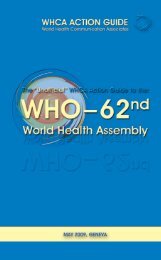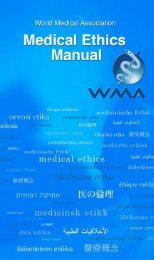the basics - World Health Communication Associates
the basics - World Health Communication Associates
the basics - World Health Communication Associates
- No tags were found...
Create successful ePaper yourself
Turn your PDF publications into a flip-book with our unique Google optimized e-Paper software.
• Written communication regarding medications and tests;• Techniques utilized by health providers to ensure patient comprehension ofhealth information (commonly referred to as “teach back methods”); and• Patient-provider relationship.For more information see https://www.cahps.ahrq.gov/default.asp3.1 CURRENT MEASUREMENT TOOLS—INDIVIDUAL SKILLS ANDABILITIESREALMThe Rapid Estimate of Adult Literacy in Medicine (REALM) is a word recognitiontest. Patients are asked to read a list of 66 increasingly difficult medical terms. Thenumber of correctly pronounced words is subsequently related to approximate gradelevels of reading (0-18: third grade and below; 19-44: fourth to sixth grade; 45-60:seventh and eighth grade; 61-66: ninth grade and above). REALM is simple, brief(administered in two to three minutes) and useful for profiling patients’ reading skills.TOFHLA and S-TOFHLAComprehension tests—such as <strong>the</strong> Test of Functional <strong>Health</strong> Literacy in Adults(TOFHLA) and <strong>the</strong> Short Test of Functional <strong>Health</strong> Literacy in Adults (S-TOFHLA)—were designed to provide a broader assessment of functional health literacy. Theytake into account reading comprehension and quantitative literacy (numeracy).TOFHLA uses three passages of prose to assess reading comprehension. Theseare: (1) instructions for <strong>the</strong> preparation for an upper gastrointestinal tract x-ray, (2)<strong>the</strong> patient rights and responsibilities section of a selected application form, and(3) a standard hospital consent form. Each of <strong>the</strong>se passages has about every fifthword eliminated and <strong>the</strong> respondent is asked to choose <strong>the</strong> most appropriate word tocomplete <strong>the</strong> sentence.S-TOFHLA uses only <strong>the</strong> first two passages. For both <strong>the</strong> TOFHLA and <strong>the</strong>S-TOFHLA, hospital forms and prescription bottles are also used to assess a patient’snumeracy skills, such as instructions for taking medication, appointment schedules,blood pressure and glucose monitoring, and obtaining financial assistance for bothof <strong>the</strong>se tests.24SECTION 3: HOW IS HEALTH LITERACY MEASURED?






